Investigation of Crack Propagation and Healing of Asphalt Concrete Using Digital Image Correlation
Abstract
1. Introduction
2. Materials and Methods
2.1. Specimen Preparation
2.2. Experimental Setup
2.3. Healing
- Healing time (HT), which represents the time it takes for the surface strain to reach its minimum value,
- Percentage of the strain recovery (H%) defined as the percentage of strain recovery on the surface of the sample,
- Strain recovery speed (SR) which represents the speed of strain recovery on the surface of the specimens.
3. Results and Discussion
3.1. Full-Field Strain and Crack Detection
3.2. Healing Phenomenon Near the Microcracks
3.3. Proposed Healing Indices
4. Conclusions
- This method is able to predict the location of the cracks and observe the healing phenomenon happening in the microcracks.
- It is possible to observe the amount of healing of different microcracks on the surface of the specimens and it was shown that, as predicted in the healing models, the tip of the microcracks heals more than their widest part.
- The amount of time it takes for the specimens to heal around the microcracks (HT) can be calculated. This value can be used to plan the minimum time that is required for an asphalt mixture to have its maximum healing at a certain temperature.
- Finally, two parameters of strain recovery (H%) and strain recovery speed (SR), which can be used qualitatively to compare the healing ability and healing speed of different mixtures, were proposed and calculated for a mixture.
Author Contributions
Funding
Conflicts of Interest
References
- García, Á. Self-healing of open cracks in asphalt mastic. Fuel 2012, 93, 264–272. [Google Scholar] [CrossRef]
- Xiao, D. State-of-the-art and prospect for self-healing asphalt concrete. In AIP Conference Proceedings; AIP Publishing: Melville, NY, USA, 2017; Volume 1864. [Google Scholar]
- Bommavaram, R.; Bhasin, A.; Little, D. Determining intrinsic healing properties of asphalt binders. Transp. Res. Rec. J. Transp. Res. Board 2009, 2126, 47–54. [Google Scholar] [CrossRef]
- Sun, D.; Sun, G.; Zhu, X.; Guarin, A.; Li, B.; Dai, Z.; Ling, J. A comprehensive review on self-healing of asphalt materials: Mechanism, model, characterization and enhancement. Adv. Colloid Interface Sci. 2018. [Google Scholar] [CrossRef] [PubMed]
- Ayar, P.; Moreno-Navarro, F.; Rubio-Gamez, M.C. The healing capability of asphalt pavements: A state of the art review. J. Clean. Prod. 2016, 113, 28–40. [Google Scholar] [CrossRef]
- Daniel, J.S.; Kim, Y.R. Laboratory evaluation of fatigue damage and healing of asphalt mixtures. J. Mater. 2002, 13, 434–440. [Google Scholar] [CrossRef]
- Kim, Y.; Little, D.N.; Lytton, R.L. Fatigue and healing characterization of asphalt mixtures. J. Mater. Civ. Eng. 2003, 15, 75–83. [Google Scholar] [CrossRef]
- Shan, L.; Tan, Y.; Underwood, S.; Kim, Y.R. Application of thixotropy to analyze fatigue and healing characteristics of asphalt binder. Transp. Res. Rec. 2010, 2179, 85–92. [Google Scholar] [CrossRef]
- Roque, R.; Simms, R.; Chen, Y.; Koh, C.; Lopp, G. Development of A Test Method That Will Allow Evaluation and Quantification of the Effects of Healing on Asphalt Mixture; University of South Florida, College of Engineering: Tampa, FL, USA, 2012. [Google Scholar]
- Schapery, R.A. Correspondence principles and a generalized J integral for large deformation and fracture analysis of viscoelastic media. Int. J. Fract. 1984, 25, 195–223. [Google Scholar] [CrossRef]
- Si, Z.; Little, D.N.; Lytton, R.L. Characterization of microdamage and healing of asphalt concrete mixtures. J. Mater. Civ. Eng. 2002, 14, 461–470. [Google Scholar] [CrossRef]
- Shen, S.; Chiu, H.-M.; Huang, H. Characterization of fatigue and healing in asphalt binders. J. Mater. Civ. Eng. 2010, 22, 846–852. [Google Scholar] [CrossRef]
- Kim, B.; Roque, R. Evaluation of healing property of asphalt mixtures. Transp. Res. Rec. J. Transp. Res. Board 2006, 1970, 84–91. [Google Scholar] [CrossRef]
- Verstraeten, J. Loi de Fatigue en Flexion Repetee des Melanges Bitumineux.; Bulletin de Liaison des Labratoires des Ponts et Chaussees; Institut Francais des Sciences et Technologies des Transports, de l’Aménagement et des Réseaux (IFSTTAR): Paris, France, 1974. [Google Scholar]
- Van Den Bergh, W.; Kara, P.; Anthonissen, J.; Margaritis, A.; Jacobs, G.; Couscheir, K. Recommendations and strategies for using reclaimed asphalt pavement in the Flemish Region based on a first life cycle assessment research. IOP Conf. Ser. Mater. Sci. Eng. 2017, 236. [Google Scholar] [CrossRef]
- Liu, Q.; Li, B.; Schlangen, E.; Sun, Y.; Wu, S. Research on the mechanical, thermal, induction heating and healing properties of steel slag/steel fibers composite asphalt mixture. Appl. Sci. 2017, 7, 1088. [Google Scholar] [CrossRef]
- Norambuena-contreras, J.; Gonzalez-torre, I. Influence of the microwave heating time on the self-healing properties of asphalt mixtures. Appl. Sci. 2017, 7, 1076. [Google Scholar] [CrossRef]
- Su, J.F.; Yang, P.; Wang, Y.Y.; Han, S.; Han, N.X.; Li, W. Investigation of the self-healing behaviors of microcapsules/bitumen composites by a repetitive direct tension test. Materials 2016, 9, 600. [Google Scholar] [CrossRef] [PubMed]
- Tabaković, A.; Schuyffel, L.; Karač, A.; Schlangen, E. An evaluation of the efficiency of compartmented alginate fibres encapsulating a rejuvenator as an asphalt pavement healing system. Appl. Sci. 2017, 7, 647. [Google Scholar] [CrossRef]
- Seo, Y.; Kim, Y.; Witczak, M.; Bonaquist, R. Application of digital image correlation method to mechanical testing of asphalt-aggregate mixtures. Transp. Res. Rec. 2002, 1789, 162–172. [Google Scholar] [CrossRef]
- Wen, H.; Kim, Y. Simple performance test for fatigue cracking and validation with westrack mixtures. Transp. Res. Rec. 2002, 1789, 66–72. [Google Scholar] [CrossRef]
- Seo, Y.; Chehab, G.R.; Kim, Y.R. Viscoelastoplastic damage characterization of asphalt–aggregate mixtures using digital image correlation. Int. J. Geomech. 2007, 111–118. [Google Scholar] [CrossRef]
- Birgisson, B.; Montepara, A.; Romeo, E.; Roncella, R.; Napier, J.A.L.; Tebaldi, G. Determination and prediction of crack patterns in hot mix asphalt (HMA) mixtures. Eng. Fract. Mech. 2008, 75, 664–673. [Google Scholar] [CrossRef]
- Tan, Y.; Hou, M.; Zhang, L.; Zhang, K. Studying the strain field distribution of asphalt mixture with the digital speckle correlation method. Road Mater. Pavement Des. 2014, 15, 90–101. [Google Scholar] [CrossRef]
- Birgisson, B.; Montepara, A.; Romeo, E.; Roque, R. Road materials and pavement design influence of mixture properties on fracture mechanisms in asphalt mixtures influence of mixture properties on fracture mechanisms in asphalt mixtures. Road Mater. Pavement Des. 2010, 0629, 37–41. [Google Scholar] [CrossRef]
- Rashadul Islam, M.; Vallejo, M.J.; Tarefder, R.A. Crack propagation in hot mix asphalt overlay using extended finite-element model. J. Mater. Civ. Eng. 2016, 29, 04016296. [Google Scholar] [CrossRef]
- Birgisson, B.; Montepara, A.; Romeo, E.; Roque, R.; Roncella, R.; Tebaldi, G. Determination of fundamental tensile failure limits of mixtures. In Proceedings of the Asphalt Paving Technology-Proceedings, San Antonio, TX, USA, 11–14 March 2007; pp. 303–344. [Google Scholar]
- Jeoffroy, E. Activated Crack Healing of Bituminous Materials. Ph.D. Thesis, ETH Zurich, Zürich, Switzerland, 2017. [Google Scholar]
- Bueno, M.; Arraigada, M.; Partl, M.N. Damage detection and artificial healing of asphalt concrete after trafficking with a load simulator. Mech. Time-Depend. Mater. 2016, 20, 265–279. [Google Scholar] [CrossRef]
- Tsangouri, E.; Aggelis, D.G.; Van Tittelboom, K.; De Belie, N.; Van Hemelrijck, D. Detecting the activation of a self-healing mechanism in concrete by acoustic emission and digital image correlation. Sci. World J. 2013, 2013. [Google Scholar] [CrossRef] [PubMed]
- Bureau voor Normalisatie. NBN EN 12697-35:2016 Bituminous Mixtures—Test Methods—Part 35: Laboratory Mixing; Bureau voor Normalisatie: Brussels, Belgium, 2016. [Google Scholar]
- Bureau voor Normalisatie. NBN EN 12697-31:2007 Bituminous Mixtures—Test Methods for Hot Mix Asphalt—Part 31: Specimen Preparation by Gyratory Compactor; Bureau voor Normalisatie: Brussels, Belgium, 2007. [Google Scholar]
- Lecompte, D.; Smits, A.; Bossuyt, S.; Sol, H.; Vantomme, J.; Van Hemelrijck, D.; Habraken, A.M. Quality assessment of speckle patterns for digital image correlation. Opt. Lasers Eng. 2006, 44. [Google Scholar] [CrossRef]
- Romeo, E. Two-dimensional digital image correlation for asphalt mixture characterisation: interest and limitations. Road Mater. Pavement Des. 2013, 14, 747–763. [Google Scholar] [CrossRef]
- Xing, C.; Tan, Y.; Liu, X.; Anupam, K.; Scarpas, T. Research on local deformation property of asphalt mixture using digital image correlation. Constr. Build. Mater. 2017, 140, 416–423. [Google Scholar] [CrossRef]
- Bureau voor Normalisatie. NBN EN 12697-24:2012 Bituminous Mixtures—Test Methods for Hot Mix Asphalt—Part 24: Resistance to Fatigue; Bureau voor Normalisatie: Brussels, Belgium, 2012. [Google Scholar]
- Liu, Q. Induction Healing of Porous Asphalt Concrete; Delft University of Technology: Delft, The Netherlands, 2012. [Google Scholar]
- Hasheminejad, N.; Margaritis, A.; Ribbens, B.; Vuye, C.; Blom, J.; Van den Bergh, W.; Dirckx, J.; Vanlanduit, S. Digital image correlation to investigate crack propagation and healing of asphalt concrete. Proceedings 2018, 2, 473. [Google Scholar] [CrossRef]
- Van Der Zwaag, S.; Robert, H.; Osgood, R.M.; Parisi, J.; Warlimont, H. Self Healing Materials—An Alternative Approach to 20 Centuries of Materials Science; Springer Science+Business Media B.V.: Dordrecht, The Netherlands, 2008; Volume 5, ISBN 9783540766629. [Google Scholar]
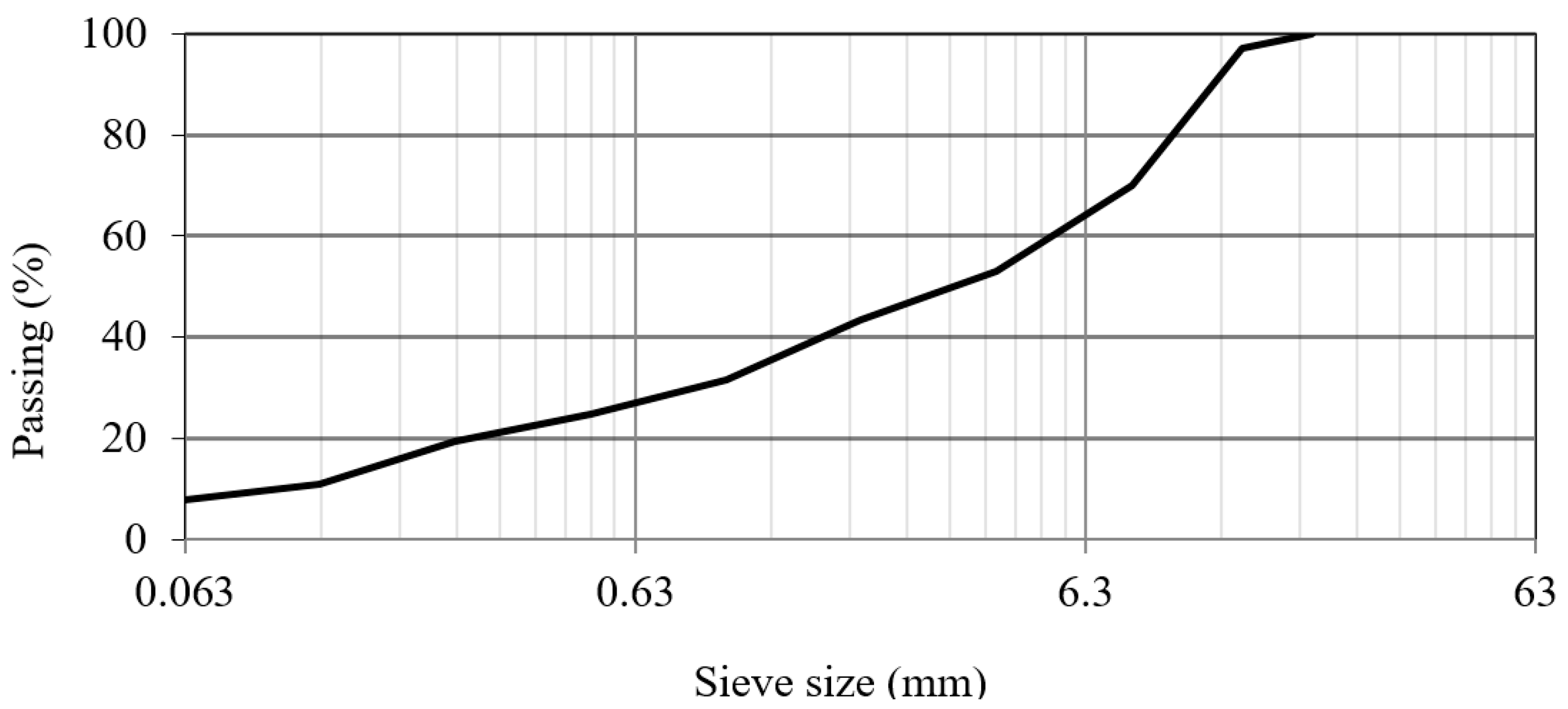
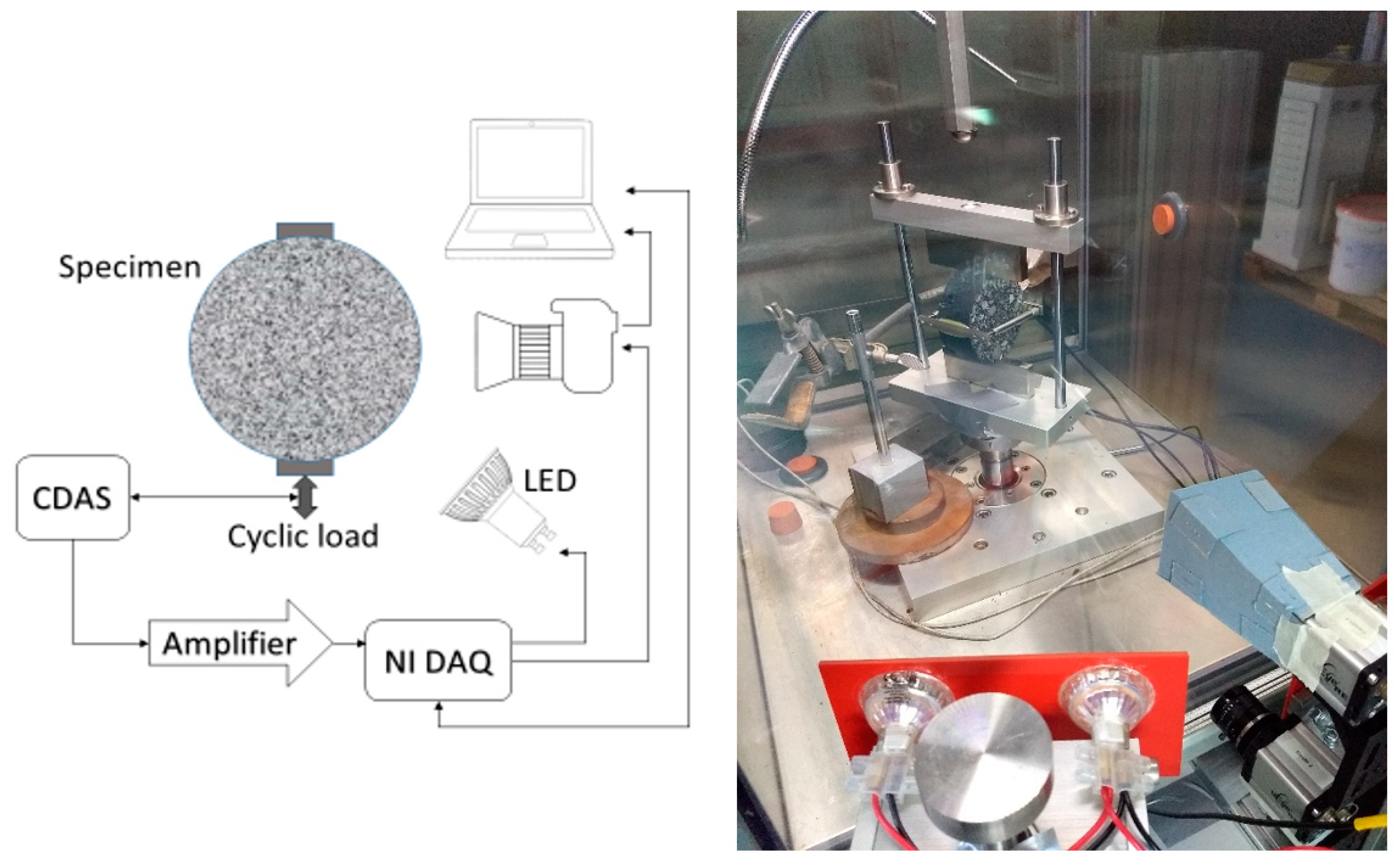
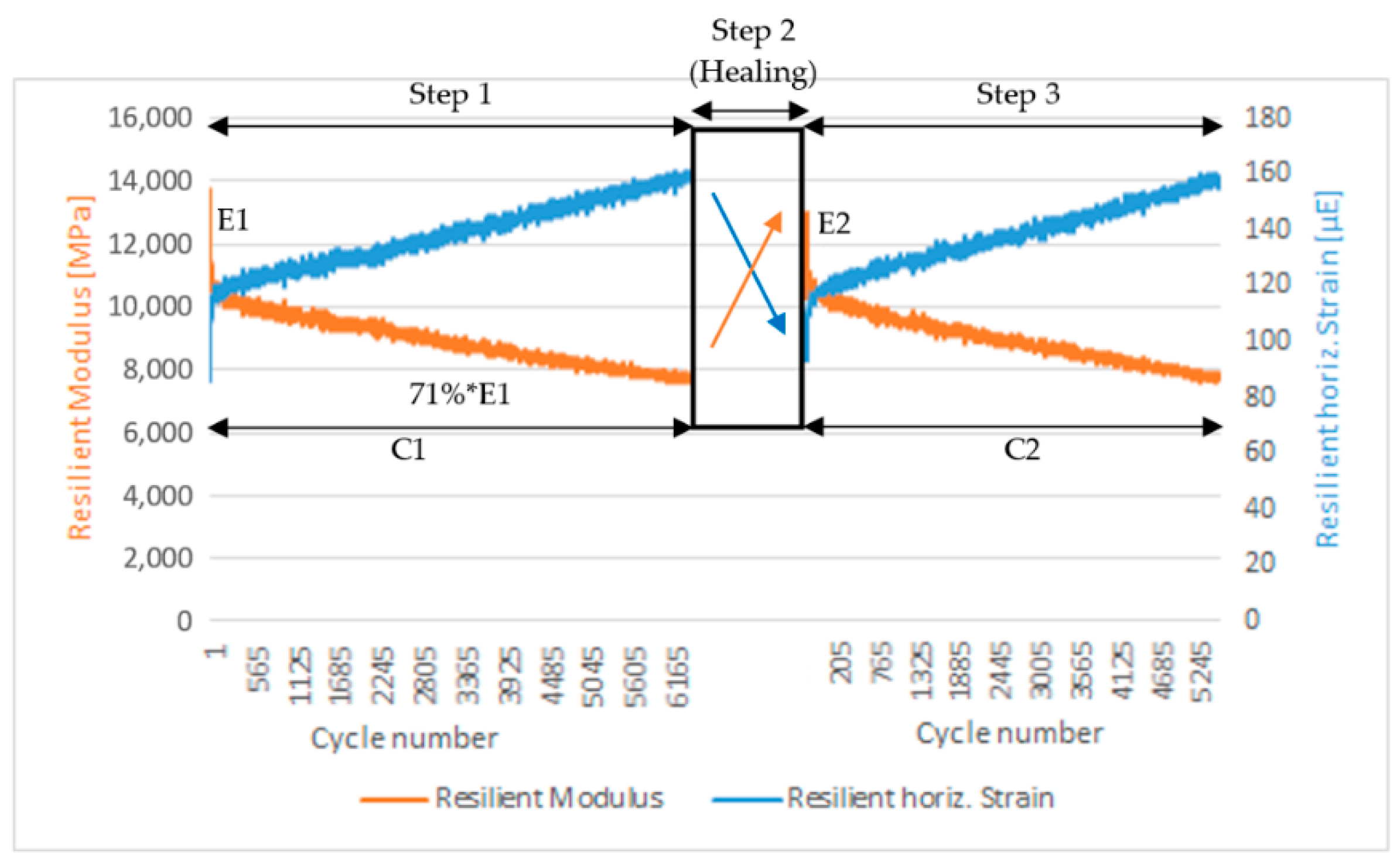

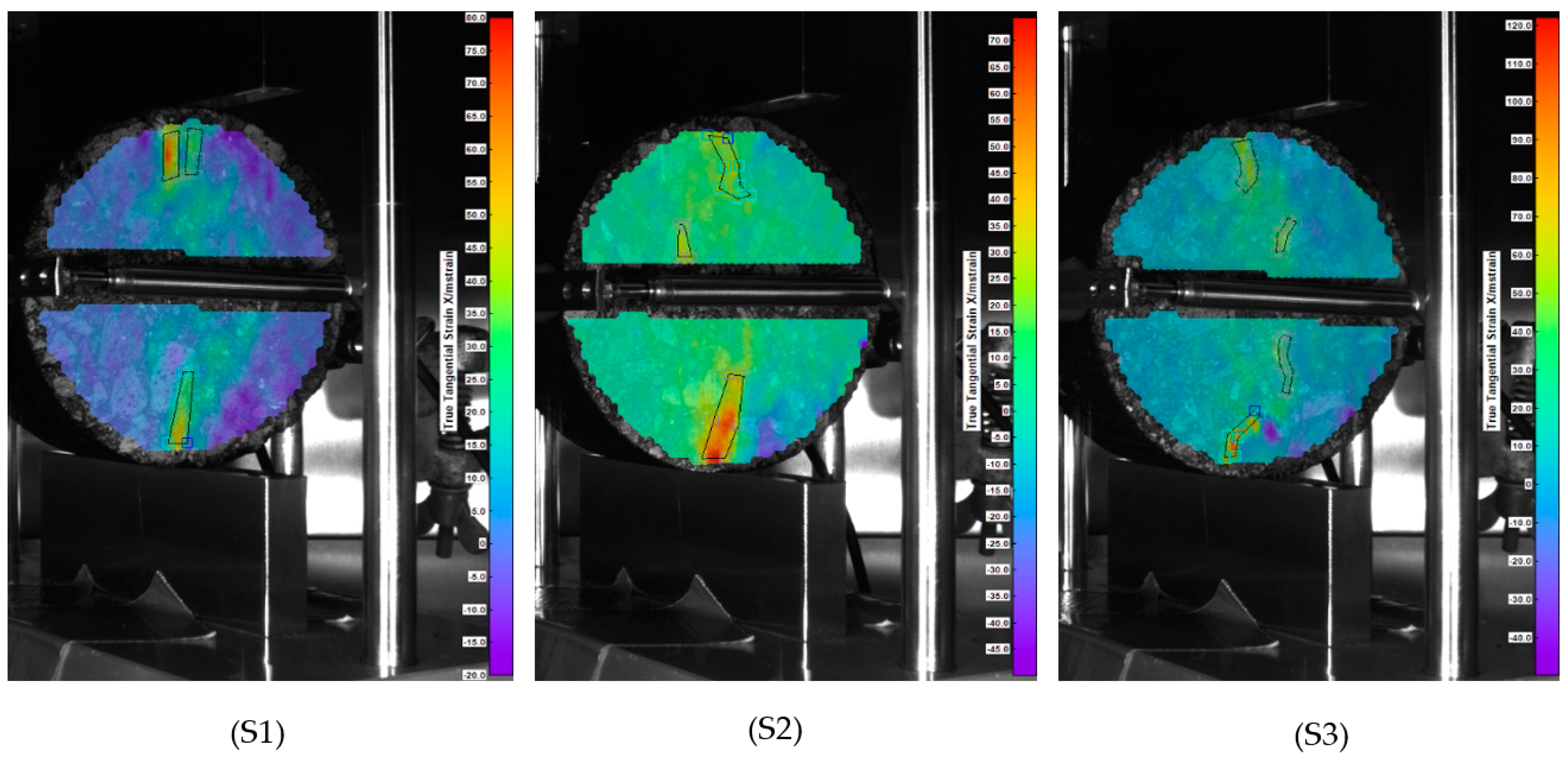
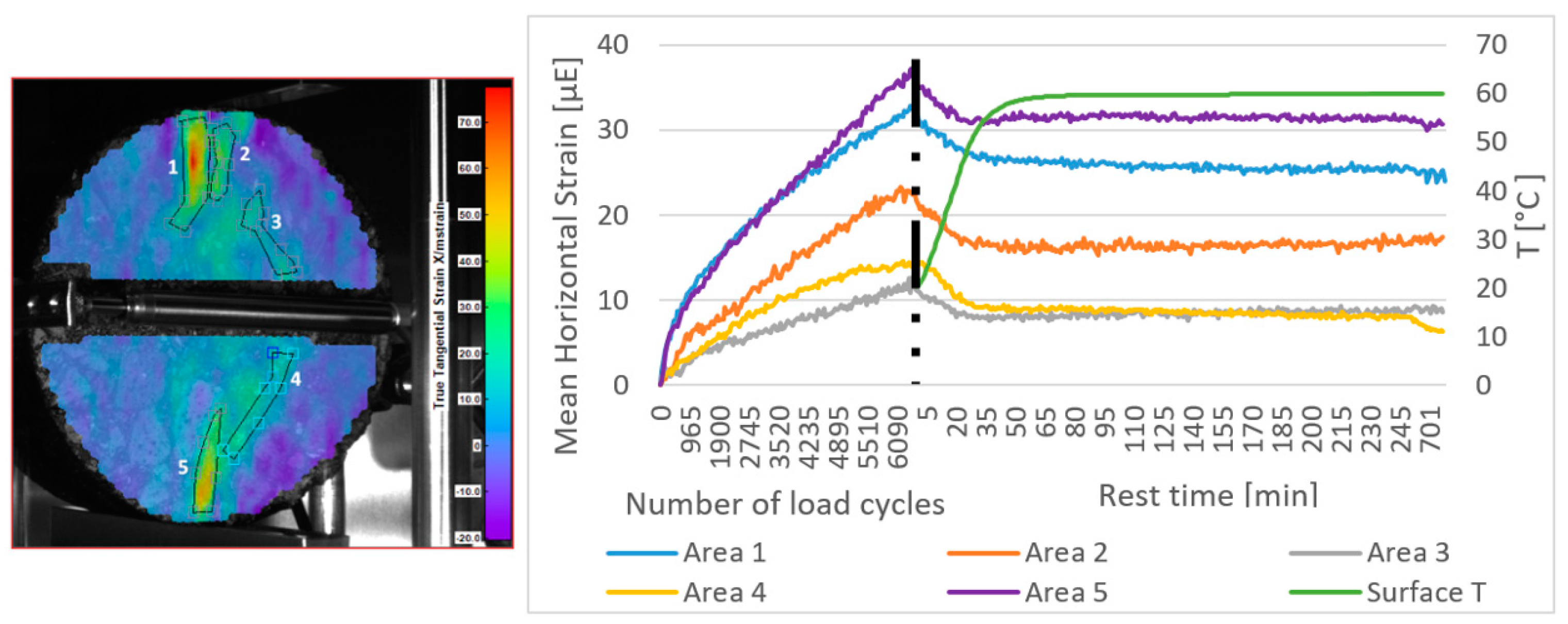
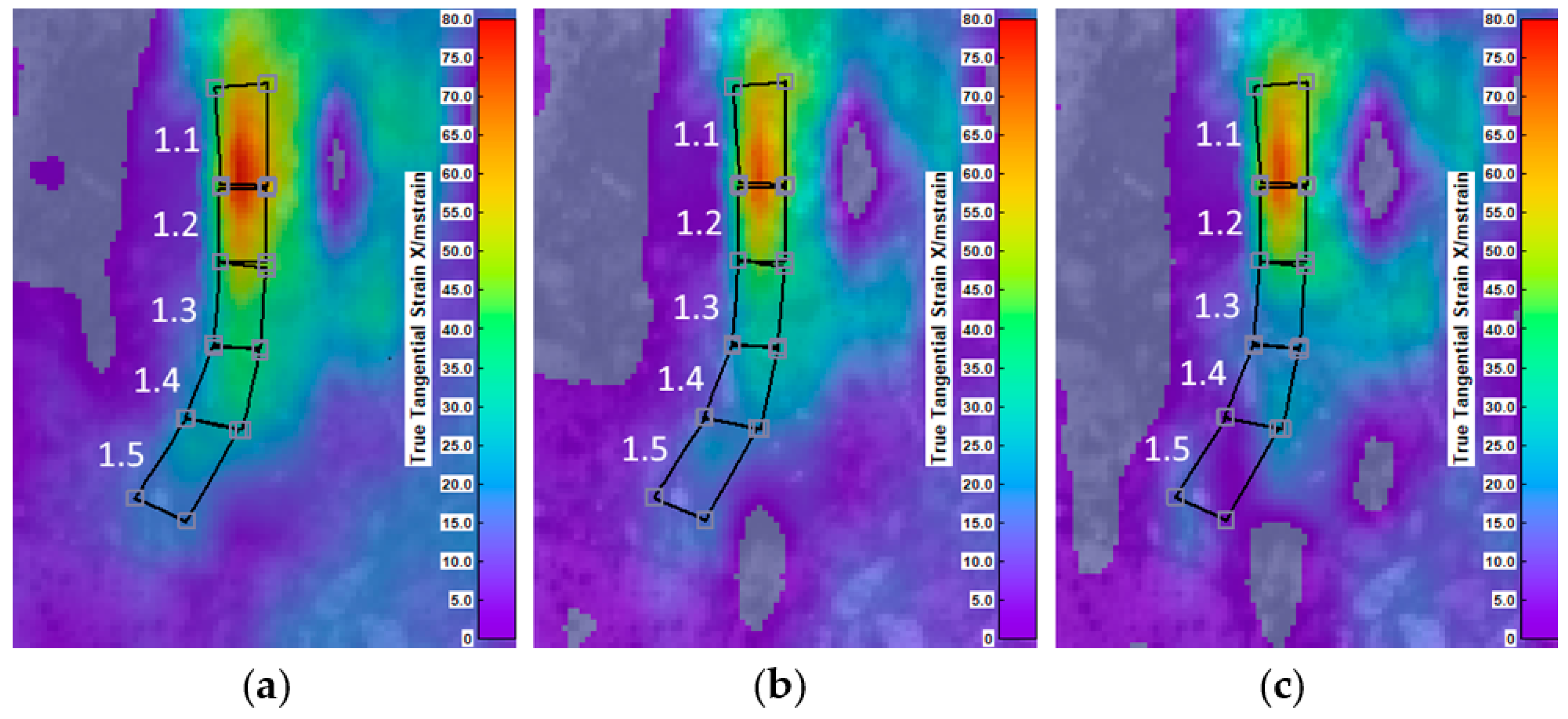
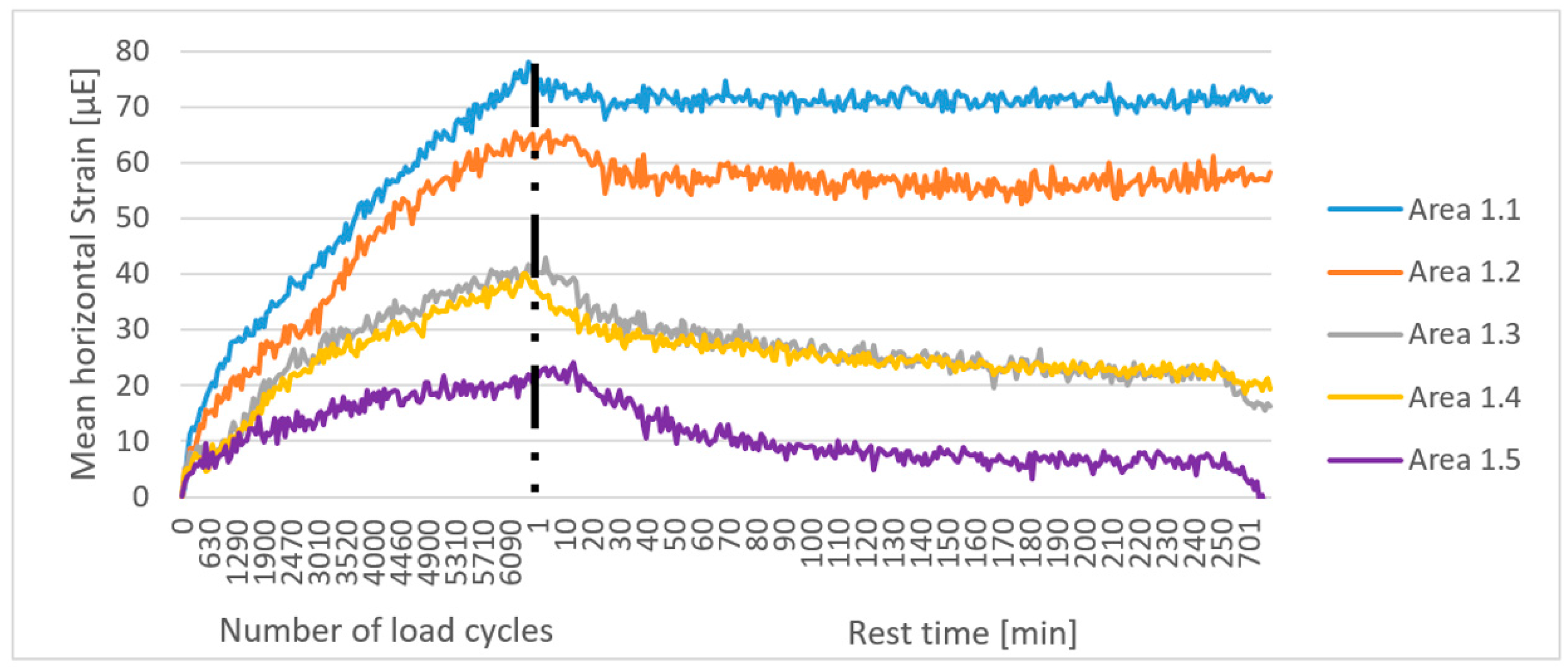
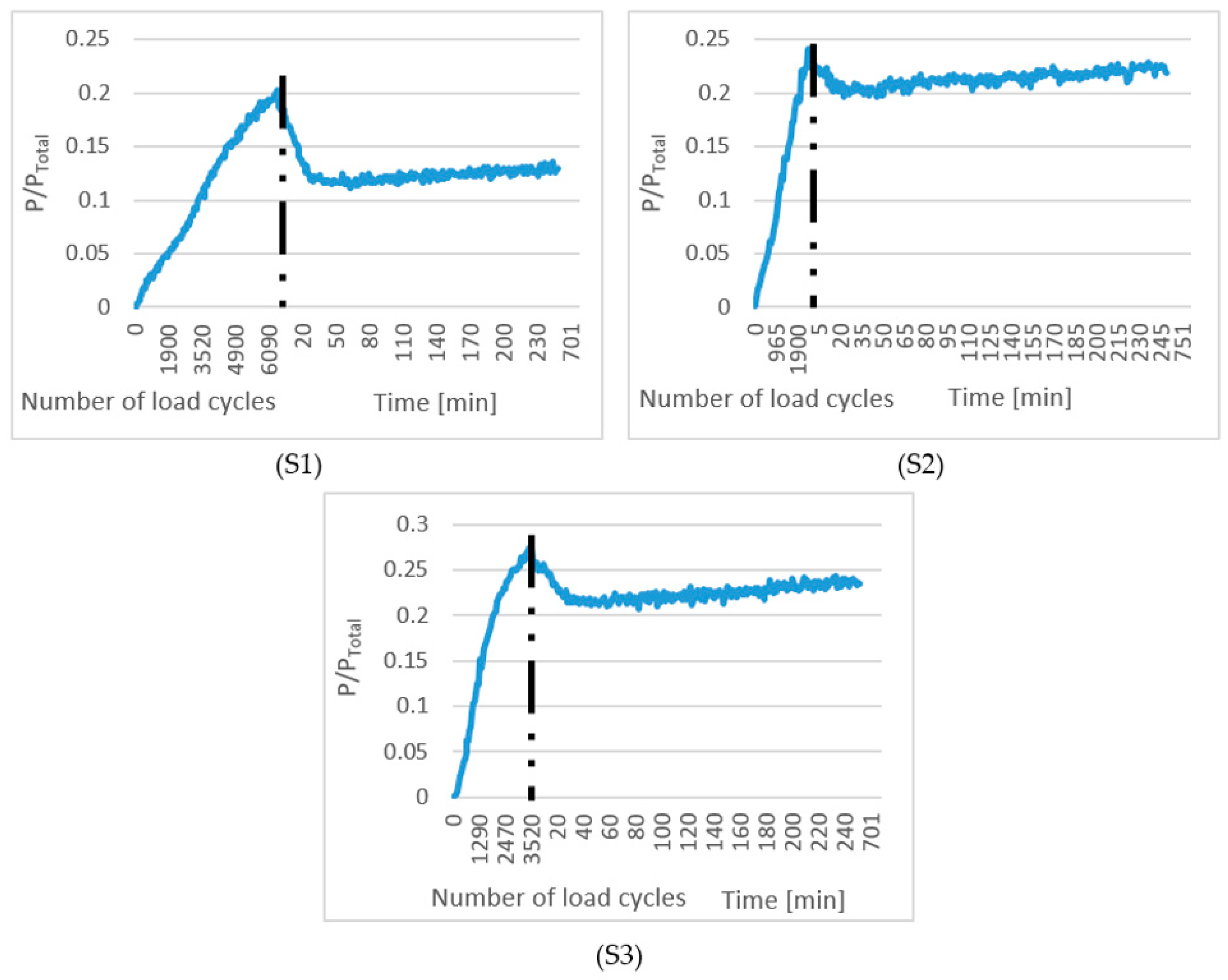
| Penetration (1/10 mm) | 37 |
| Softening point (°C) | 54.3 |
| Fraass breaking point (°C) | −10 |
| Limestone 6.3/14 | 39.8% |
| Limestone 2/6.3 | 14.0% |
| Limestone 0/2 | 30.0% |
| River sand 0/1 | 7.5% |
| Filler (filler 15) | 8.7% |
| UTM | DIC | ||||
|---|---|---|---|---|---|
| EI | RI | HT [min] | H% | SR [µε/min] | |
| S1 | 0.86 | 0.99 | 31 | 42.3 | 0.0028 |
| S2 | 0.86 | 0.92 | 23 | 18.87 | 0.0020 |
| S3 | 0.94 | 0.99 | 34 | 21.98 | 0.0018 |
| Average | 0.89 | 0.97 | 29.33 | 27.72 | 0.0022 |
| SD | 0.05 | 0.04 | 5.69 | 12.72 | 0.0005 |
© 2019 by the authors. Licensee MDPI, Basel, Switzerland. This article is an open access article distributed under the terms and conditions of the Creative Commons Attribution (CC BY) license (http://creativecommons.org/licenses/by/4.0/).
Share and Cite
Hasheminejad, N.; Vuye, C.; Margaritis, A.; Ribbens, B.; Jacobs, G.; Blom, J.; Van den bergh, W.; Dirckx, J.; Vanlanduit, S. Investigation of Crack Propagation and Healing of Asphalt Concrete Using Digital Image Correlation. Appl. Sci. 2019, 9, 2459. https://doi.org/10.3390/app9122459
Hasheminejad N, Vuye C, Margaritis A, Ribbens B, Jacobs G, Blom J, Van den bergh W, Dirckx J, Vanlanduit S. Investigation of Crack Propagation and Healing of Asphalt Concrete Using Digital Image Correlation. Applied Sciences. 2019; 9(12):2459. https://doi.org/10.3390/app9122459
Chicago/Turabian StyleHasheminejad, Navid, Cedric Vuye, Alexandros Margaritis, Bart Ribbens, Geert Jacobs, Johan Blom, Wim Van den bergh, Joris Dirckx, and Steve Vanlanduit. 2019. "Investigation of Crack Propagation and Healing of Asphalt Concrete Using Digital Image Correlation" Applied Sciences 9, no. 12: 2459. https://doi.org/10.3390/app9122459
APA StyleHasheminejad, N., Vuye, C., Margaritis, A., Ribbens, B., Jacobs, G., Blom, J., Van den bergh, W., Dirckx, J., & Vanlanduit, S. (2019). Investigation of Crack Propagation and Healing of Asphalt Concrete Using Digital Image Correlation. Applied Sciences, 9(12), 2459. https://doi.org/10.3390/app9122459








